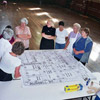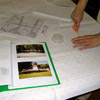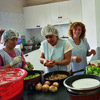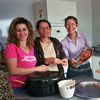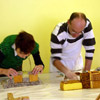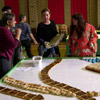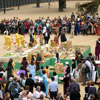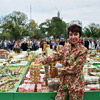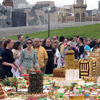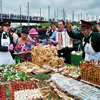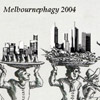Eating the City, Melbourne, 2004
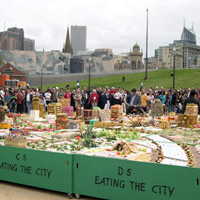 |
Eating the City, Melbourne was commissioned and financed by the Melbourne City Council in order to commemorate a ritual of passage- the inauguration of Federation Square, the city's newest public space and icon. The event was designed as a celebration of community, symbolising the coming together of all the cultural energies that flow through Melbourne and make it the vibrant cultural centre it is. It paid tribute to the contribution of all the groups that over the years have made Melbourne their home, building new lives and changing the face of the city. It also highlighted the importance of food to cultural identity and its ability to facilitate the building of relationships and a sense of community, promoting peace and coexistence.
Melbourne, a very modern city commonly thought of as belonging to the 'New World', is also home to one of the oldest peoples on earth, the Australian Aborigines. Since British colonisation, people from many different countries have immigrated to Australia and many still come, creating a particularly multicultural society.
35 of the city's ethnic and community groups were involved in Eating the City, including the local Aboriginals, the Spanish, Ethiopian, Indonesian and Pacific Island communities, and several of the city's soup kitchens and refuges. Groups were assigned one of the 20 sections into which the map of Melbourne was divided, each section measuring 2m x 2m, which they were responsible for interpreting with their own cuisine. The sections of the map were assembled atop tables specially designed by Bárbara Ortíz which had wheels and perforations in the sides to enable them to be skewered with beams and carried. Each group presented their section to the community in a procession illustrating their unique heritage and identity through costume, music and dance.
The idea was to incorporate and share the pleasure these communities derive from their vernacular idiosyncrasies; performance, music, dancing and cuisine, to recall, to pay homage, to revive and integrate their past into their present in a continuum along with the rest of the communities. All the groups were granted the same amount of space to represent and thus shared the same protagonism, third generation immigrants and recent arrivals alike.
Ali&Cia, with the help of Australian food consultant Gay Bilson, coordinated with all the communities, holding workshops to decide which traditional ingredients and dishes would be used to build all the urban elements of the part of the city centre of Melbourne they had been assigned, and some tips were given on construction techniques. For the cooking the communities were assisted by students from William Angliss TAFE Cooking School and a theatre worker helped to plan the processions and co-ordinate the entrance of the tables.
The event was held alongside Federation Square, in an area by the banks of the Yarra River called Birrarung Mar. As the original inhabitants, the Aboriginal community made an official greeting to all those present and their table was the first to be presented.
One by one the tables were carried in, accompanied by music, song and dance, and pieced together to form a map of 8 x 10 metres. Alicia addressed the crowd of almost 4000 people, inviting them to release their inner urbanophagist and participate in the communal catharsis of eating the city of Melbourne. The tables were separated to allow access and members of the communities served up the city for all to devour.
One of the things that Eating the City, Melbourne, demonstrated clearly is the importance of food to communities. In the case of ethnic communities, food illustrates traditions, far off places and histories, providing a connection to the past that contributes to identity. In addition, as a shared heritage it provides a connection to others. It is also central to maintaining relations, present as it is at most celebrations, and is often itself cause for celebration. For those on society's margins, such as the homeless or those living in refuges, sharing food is especially important as a means of integrating into a community, providing an important opportunity for building relationships.
The communities in Melbourne embraced the urbanophagic perspective, creating meaningful, symbolic representations that spoke of their identity, food culture and history and surroundings all at once. One example is provided by Alicia's account of a conversation she had with an Italian woman:
Upon enquiring about their opinion of the project one woman said to me "We all love it, Alicia. For us the city of Melbourne is like a minestrone where we are all represented. The Greeks are the olive oil, the Turks are the lamb, the Chinese are the rice, the Italians are the basil, the Spanish are the saffron, the Indians are the water and so on and so on... we all form an equally essential part of it and feel represented by such a dish that, at the same time, is the building element for constructing the Queen Elizabeth Market. That's why it is so delightful and we all enjoy it and are nourished by it!"
Responding to the brief given by Ali&Cia, her group took minestrone, a typical Italian dish that speaks of their identity and cultural heritage, and applied it's rich symbolism as fruit of intercultural relations and trade, a product of supply and circumstance, to represent the colourful Queen Elizabeth Market and multicultural Melbourne as a whole. As opposed to the often quoted 'melting pot' social model, another cooking analogy, in this Italian model the various parts all contribute flavour while retaining their identity.
A further example of the poetic, sometimes surreal, perspective engendered by Alic&Cia's urbanophagy projects if offered by another of Alicia's anecdotes:
During one of the workshop sessions, in this case with the Vietnamese, an elderly woman was baking something in the oven. I asked her "What are you baking?" And! She answered me "I'm baking the parking lot!"
Participating Groups:
· Alevi Community Council
· Australia India Society of Victoria Inc.
· Australian Vietnamese Women's Welfare Association
· Boonerwrung Elder Carolyn Briggs
· CPCA Centre for Philippine Concerns Australia
· The Country Women's Association of Victoria Inc.
· Credo Café (Urban Seed)
· EEAMA League of Greeks from Egypt and the Middle East
· Federation of Chinese Welfare Associations
· Hogar Español
· Horn of Africa Senior Women's Program
· Hume Arabic Women's Group
· Indian Senior Citizens Associations of Victoria
· Indonesian Society of Victoria Inc. Perwira
· Italian Senior Citizens Club at Merrilands
· METAC Melbourne East Timor Activity Centre
· Nase Zene Slavic Women's Group
· Ozanam House, St Vincent de Paul Aged Care and Community Services
· Pasifika Victoria
· Regina Coeli Community Inc.
· Sangam Community Association Inc.
· Torres Strait Islander Elder Ella Pitt
· United Somali Women's Group
· William Angliss TAFE. Gordon Talty and students of Certificate III in Hospitality (Commercial Cookery)
Video
Eating the City, Melbourne (see video)
Video by Diego Vega for Ali&Cia
|

